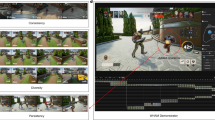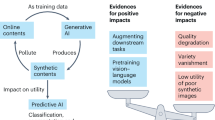Abstract
Advances in generative algorithms have enhanced the quality and accessibility of artificial intelligence (AI) as a tool in building synthetic datasets. By generating photorealistic images and videos, these networks can pose a major technological disruption to a broad range of industries from medical imaging to virtual reality. However, as artwork developed by generative algorithms and cognitive robotics enters the arena, the notion of human-driven creativity has been thoroughly tested. When creativity is automated by the programmer, in a style determined by the trainer, using features from information available in public and private datasets, who is the proprietary owner of the rights in AI-generated artworks and designs? This Perspective seeks to provide an answer by systematically exploring the key issues in copyright law that arise at each phase of artificial creativity, from programming to deployment. Ultimately, four guiding actions are established for artists, programmers and end users that utilize AI as a tool such that they may be appropriately awarded the necessary proprietary rights.
This is a preview of subscription content, access via your institution
Access options
Access Nature and 54 other Nature Portfolio journals
Get Nature+, our best-value online-access subscription
$29.99 / 30 days
cancel any time
Subscribe to this journal
Receive 12 digital issues and online access to articles
$119.00 per year
only $9.92 per issue
Buy this article
- Purchase on SpringerLink
- Instant access to full article PDF
Prices may be subject to local taxes which are calculated during checkout


Similar content being viewed by others
References
Lin, Y. & Pan, D. Z. in Machine Learning in VLSI Computer-Aided Design (eds Elfadel, I. M., Boning, D. S. & Li, X.) 95–115 (Springer, 2018).
Chui, M. et al. Notes from the AI frontier: Insights from Hundreds of Use Cases (McKinsey Global Institute, 2018).
Goodfellow, I. et al. Generative adversarial nets. In Advances in Neural Information Processing Systems 2672–2680 (NeurIPS, 2014).
Radford, A., Metz, L. & Chintala, S. Unsupervised representation learning with deep convolutional generative adversarial networks. In Int. Conf. Learning Representations (ICML, 2015).
Barrat, R. art-DCGAN (GitHub, accessed 18 January 2019); https://github.com/robbiebarrat/art-DCGAN
Chintala, S. DCGAN (GitHub, accessed 10 October 2019); https://github.com/soumith/dcgan.torch
Aplin, T. & Pasqualetto, G. Regulating Industrial Internet through IPR, Data Protection and Competition Law (eds Ballardini, R. M. et al.) Ch. 5 (Wolters Kluwer, 2019).
Guadamuz, A. Do androids dream of electric copyright? Comparative analysis of originality in artificial intelligence generated works. Intell. Prop. Q. 2, 169–186 (2017).
LeCun, Y., Bengio, Y. & Hinton, G. Deep learning. Nature 521, 436–444 (2015).
Berne Convention for the Protection of Literary and Artistic Works: Paris Act of 24 July 24 1971, as amended on 28 September 1979, Article 2, paragraph 2.
Sterling, J. A. L. World Copyright Law 198–201 (2018).
Feist Publications, Inc. v. Rural Telephone Service Co. 499 US340 (1991).
Ladbroke (Football) Ltd v. William Hill (Football) Ltd 1 WLR 273 (HL) (1964).
Infopaq International A/S v. Danske Dagblades Forening C-5/08 (2009).
CCH v. Law Society of Upper Canada 1 SCR 339, 2004 SCC 13, 236 DLR (4th) 395, 30 CPR (4th) 1, 247 FTR 318 CHH (2004).
Telstra Corporation Ltd v. Phone Directories Company Pty Ltd FCAFC 149 (2010).
Compendium of U. S. Copyright Office Practices 3rd edn § 306 (US Copyright Office, 2017).
Warner-Lambert Co Ltd v. Generics (UK) Ltd (2018).
Copyright, Designs and Patents Act 1988 (UK), s9(3).
Copyright and Related Acts, 2000 (Ireland), s.21(f).
New Zealand Copyright Act 1994 s5(2)(a).
SAS Institute Inc. v. World Programming Ltd EWCA Civ 1482, 2014. RPC 8 (2013).
Samuelson, P. Allocating ownership rights in computer-generated works. U. Pitt. L. Rev. 47, 1185–1228 (1985).
Copyright Act of 1976 (USA) s.503.03(a).
Copyright Act 1968 (Australia) s.32.
Perry, M. & Margoni, T. From music tracks to Google Maps: who owns computer generated works? Comp. Law Security Rev. 26, 621–629 (2010).
Information Sheet G089v4: Music: DJs (Australian Copyright Council, 2014).
Hugenholtz, P. B. in Kritika: Essays on Intellectual Property (eds Ulrich, H. et al.) Ch. 3 (Edward Elgar, 2018).
Gatys, L. A., Ecker, A. S. & Bethge, M. Image style transfer using convolutional neural networks. In Proc. IEEE Conference on Computer Vision and Pattern Recognition 2414–2423 (IEEE, 2016).
Isola, I., Zhu, J. Y., Zhou, T. & Efros, A. Image-to-image translation with conditional adversarial networks. In Proc. IEEE Conf. Computer Vision and Pattern Recognition 1125–1134 (IEEE, 2017).
Nova Productions Ltd v. Mazooma Games Ltd RPC 379 (UK) (2006).
Rearden, LLC v. Walt Disney no. 17-cv-04006-JST, 2018 WL 1000350 (2018).
Ginsburg, J. C. & Budiardjo, L. A. Authors and machines. Berkeley Technol. J. 34, 343–448 (2019).
Wang, T.-C. et al. Video-to-video synthesis. In Advances in Neural Information Processing Systems 1152–1164 (NeurIPS, 2018).
Interlego AG v. Tyco Industries Inc AC 217, 263 (1989).
Sawkins v. Hyperion Records Ltd EWCA Civ 565, 2005. 1 WLR 3281 (2005).
Simon, J. Artbreeder http://www.artbreeder.com (2019).
Positive Black Talk Inc. v. Cash Money Records Inc. 394 F.3d 357 (2003).
Sobel, B. Artificial intelligence’s fair use crisis. Colum. J. Law Arts 41, 45 (2017).
Copyright Act 1968 (Australia) s.14.
Copyright, Designs and Patents Act 1988 (UK), s16(3)(a).
Berne Convention for the Protection of Literary and Artistic Works, Paris Act of 24 July 1971, as amended on 28 September 1979 Article 2, paragraph 3.
U.S. Code § 106.
LB (Plastics) Ltd v. Swish Products Ltd RPC 551 at 56 per Whitford J (1979).
de Castilho, R. E., Dore, G., Margoni, T., Labropoulou, P. & Gurevych, I. A legal perspective on training models for natural language processing. In Proc. Eleventh International Conference on Language Resources and Evaluation 1267–1274 (ACL, 2018).
The legal side of open source. Section 5. Open Source Guides https://opensource.guide/legal/#which-open-source-license-is-appropriate-for-my-project (2019).
Acknowledgements
Thanks to X. Feng, G. Zarrella and G. Cohen, for their invaluable discussions in the development of this manuscript, and the National Science Foundation who supported the organization of the Telluride Neuromorphic Cognition Engineering Workshop, which inspired this Perspective.
Author information
Authors and Affiliations
Corresponding author
Ethics declarations
Competing interests
The author declares no competing interests.
Additional information
Publisher’s note Springer Nature remains neutral with regard to jurisdictional claims in published maps and institutional affiliations.
Rights and permissions
About this article
Cite this article
Eshraghian, J.K. Human ownership of artificial creativity. Nat Mach Intell 2, 157–160 (2020). https://doi.org/10.1038/s42256-020-0161-x
Received:
Accepted:
Published:
Issue Date:
DOI: https://doi.org/10.1038/s42256-020-0161-x



